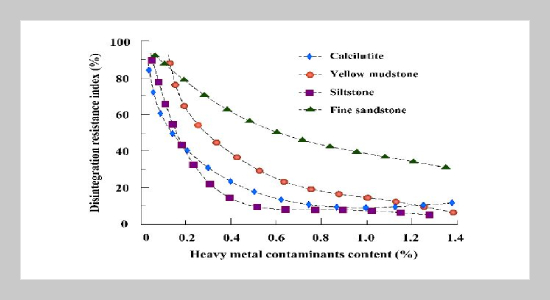REFERENCES
- [1] F. Gong, X. Li, X. Liu, and J. Zhao, (2010) “Experimental study of dynamic characteristics of sandstone under one-dimensional coupled static and dynamic loads" Chinese Journal of Rock Mechanics and Engineering 29(10): 2076–2085.
- [2] L. U. Xiao Xia and P. Zhang, (2002) “Rock Damage Viscoplastic Constitutive Relationship with Compress" Journal of Chongqing University:
- [3] M. PengSuping and M.WangHu, (2003) “PanJienan (China University of Mining and Technology, Beijing 100083 China); TESTING STUDY ON PORE RATIO AND PERMEABILITY OF SANDSTONE UNDER DIFFERENT CONFINING PRESSURES [J]" Chinese Journal of Rock Mechanics and Engineering 5:
- [4] Z. Jiang, L. Ji, R. Zuo, and L. Cao, (2002) “CORRELATIVITY AMONG ROCK PERMEABILITY AND STRAIN,STRESS UNDER SERVO-CONTROL CONDITION" Chinese Journal of Rock Mechanics&Engineering 21(10): 1442–1446.
- [5] H. J. Gang, Y. U. Min, H. B. Quan, J. F. Huang, and B. J. Tan, (2003) “Weathering velocity of slope rock in Guilin-Liuzhou expressway" Hydrogeology and Engineering Geology:
- [6] C. Pan and S. Liu, (2019) “Experimental research on thermal conductivity characteristics of heavy metal contaminated soil" Dongnan Daxue Xuebao (Ziran Kexue Ban)/Journal of Southeast University (Natural Science Edition) 49(2): 362–368.
- [7] Z. G. Cao, D. W. Zhang, and S. Y. Liu, (2013) “Experimental research on durability of solidified leadcontaminated soils under wetting-drying cycles" Rock and Soil Mechanics 34(12): 3485–3490.
- [8] M. Huang, C. H. Chen, H. Z. Yang, Z. P.Mao, and Y. B. Li, (2013) “Effects of Two Typical Regulating Agents on Cadmium Fractions in Soils Contaminated by Cadmium" Journal ofWuhan University of Technology:
- [9] T.Wang, L.Wang, F. Xue, and M. Xue, (2021) “Identification of crack development in granite under triaxial compression based on the acoustic emission signal" International Journal of Distributed Sensor Networks 17:
- [10] Qinglei, Yu, Shengqi, Yang, P., G., Ranjith,Wancheng, Zhu, and Tianhong, (2016) “Numerical Modeling of Jointed Rock Under Compressive Loading Using X-ray Computerized Tomography" Rock Mechanics & Rock Engineering:
- [11] N. Yoobanpot, P. Jamsawang, and S. Horpihulsuk, (2017) “Strength behavior and microstructural characteristics of soft clay stabilized with cement kiln dust and fly ash residue" Applied Clay Science 141(JUN.): 146–156.
- [12] H. J. Yim, H. Lee, and J. H. Kim, (2017) “Evaluation of mortar setting time by using electrical resistivity measurements" Construction & Building Materials 146(Aug.15): 679–686.
- [13] Z. K. Mi, G. Y. Li, and S. S. Chen, (2012) “Constitutive model for coarse granular materials based on breakage energy" Chinese Journal of Geotechnical Engineering 34(10): 1801–1811.
- [14] F. S. Zha, J. J. Liu, X. U. Long, Y. F. Deng, C. B. Yang, and C. F. Chu, (2019) “Electrical resistivity of heavy metal contaminated soils solidified/stabilized with cementfly ash" Rock and Soil Mechanics:
- [15] S. Liu, L. Zhan, L. Hu, and Y. Du, (2016) “Environmenta geotechnics: State-of-the-art of theory, testing and application to practice" China Civil Engineering Journal:
- [16] Y. J. Du, M. L.Wei, K. R. Reddy, and H. L. Wu, (2016) “Effect of carbonation on leachability, strength and microstructural characteristics of KMP binder stabilized Zn and Pb contaminated soils" Chemosphere 144(FEB.): 1033–1042.
- [17] , (2014) “Effect of sewage on electrical resistivity and strength of cemented soil" Yantu Lixue/Rock and Soil Mechanics 35(7): 1855–1862+1870.
- [18] L. Cheng, R. Nie, and. Liu, (2017) “An experimental study of the uniaxial compressive strength of fractured loess" Hydrogeology & Engineering Geology:
- [19] . Wang, Z. T. Shen, and H. L. Wang, (2018) “Performances of cement-stabilised/solidified contaminated site soils" Yantu Gongcheng Xuebao/Chinese Journal of Geotechnical Engineering:
- [20] T. T. Zhang, P. Wang, L. I. Jiang-Shan, Y. Wan, Q. Xue, and S. Q. Wang, (2018) “Effect of curing time and lead concentration on mechanical properties of leadcontaminated soils stabilized by magnesium phosphate cement" Rock and Soil Mechanics:
- [21] Y. Guo, L. Cao, and P. Huo, (2019) “Strength and Microstructure of Unsaturated Contaminated Soil under Two Stress Paths" Journal of Basic ence and Engineering:
- [22] Y. Xue, J. J. Chen, and L. Ce, (2014) “[Impact of compounded chelants on removal of heavy metals and characteristics of morphologic change in soil from heavy metals contaminated sites]." Environmental ence 35(2): 733.
- [23] C. Zhu, L. Pan, C. Yu, H. Wang, J. Jiang, and R. Liao, (2018) “Mechanical properties and microstructure characteristics of cement solidification pollution soil from Wenzhou" Tumu Jianzhu yu Huanjing Gongcheng/Journal of Civil, Architectural and Environmental Engineering:
- [24] Y. Feng,W. Xia, Y. Du, L. Zhang, and J. Zhao, (2017) “Experimental study on the strength and environmental properties of Ni and Zn contaminated soil stabilized by SPB and SPC binders" Yanshilixue Yu Gongcheng Xuebao/Chinese Journal of Rock Mechanics and Engineering 36(12): 3062–3074.
- [25] F. Zha, A. Hao, X. Long, J. Liu, and K. Cui, (2014) “EXPERIMENTAL STUDY OF LEACHING CHARACTERISTICS OF CEMENT SOLIDIFIED AND STABILIZED HEAVY METAL CONTAMINATED SOILS" Industrial Construction:
- [26] J. Cui, W. Xue, Z. Yan, S. Liu, and N. Wang, (2013) “Repairing of heavy metals contaminated soil with different surfactants" Journal of Dalian Polytechnic University:
- [27] T. T. Zhang, X. X. He, P. Wang, Q. Xue, and J. S. Li, (2017) “Influence of particle size and pH on stability of chromium contaminated soil and its mechanism analysis" Yantu Lixue/Rock and Soil Mechanics 38: 82–88.
- [28] Y. G. Xu, T. Cao, and F. Luo, (2014) “Wastewater Effluent Quality Prediction Model Based on Relevance Vector Machine" Huanan Ligong Daxue Xuebao/Journal of South China University of Technology (Natural Science) 42(5): 103–108.









